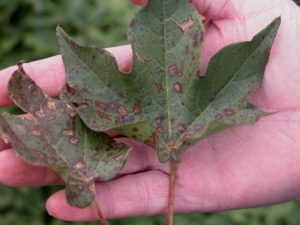Caused by: A. macrospora, A. alternata
Foliar Symptoms: Alternaria Leaf Spot forms lesions on senescing leaves that are brown with purple margins. As they expand they typically exhibit concentric zonation and the necrotic tissue will overlap with other lesions. As the disease progresses the lesions will become gray and dry with some of the necrotic tissue falling out giving it a “shot-hole” appearance.
Diagnostic Note: Symptoms of Alternaria Leaf Spot and Stemphylium Leaf Spot are similar; however Alternaria Leaf Spot is more commonly ob-served in Texas and the Mid-South and Stemphylium Leaf Spot in the Southeast. Lesions with concentric rings may appear similar to Target Spot; however spots from Alernaria Leaf Spot will be throughout the canopy and are also associated with reddening and yellowing leaves.
Range and Yield Loss: Alternaria is one of the most common cotton diseases and is associated with late season cotton development. (Note: Alternaria Leaf Spot and Stemphylium Leaf Spot are similar in that both are most severe when cotton plants have insufficient potassium, either from inadequate fertilization or during periods of drought.) Yield loss is not considered a problem with Alternaria Leaf Spot if symptoms and defoliation occur late in the season.
Reducing plant stress and insuring proper soil fertility, especially with potassium, can reduce disease severity.

